Dell XPS 12 Review: A Jack of All Trades Flipscreen Ultrabook
by Jarred Walton on February 22, 2013 2:13 AM EST- Posted in
- Laptops
- Dell
- XPS
- Intel Insider
- Ultraportable
- hybrids
- Ultrabook
Battery Life Testing
As discussed in the Acer S7 review, we’re doing away with our former battery life suite and going with a bit more up-to-date tests. This is only the second laptop we’ve run through the new suite, so our database is a bit bare, so I’m just going to throw the results into a table. The Light test is our former Internet test, only with the LCD at 200 nits (50% for the XPS 12, or five steps down from maximum). Our Medium test uses the same Internet testing procedure but loads the pages every 12 seconds instead of every 60 seconds, and we add in playback of a bunch of 128Kbps MP3 files in Windows Media Player (with headphones connected and volume set to a “reasonable” level—around 40% in this case). Finally, for our heavy workload we keep the Internet portion of the Medium test but add in looped playback of a 1080p H.264 encoded video and have a constant 1Mbps download running from a local FTP server.
| 2013 Battery Tests | ||
| Battery Test | Acer Aspire S7 | Dell XPS 12 |
| 2013 Light (Minutes) | 240 | 321 |
| 2013 Medium (Minutes) | 173 | 257 |
| 2013 Heavy (Minutes) | 137 | 183 |
| Light Normalized (Min/Wh) | 6.86 | 6.83 |
| Medium Normalized (Min/Wh) | 4.94 | 5.47 |
| Heavy Normalized (Min/Wh) | 3.91 | 3.89 |
Dell’s XPS 12 wins on pure battery life compared to the Acer S7, but it’s largely thanks to the increased battery capacity. That adds weight as well as thickness, so it’s not necessarily a trade everyone will be willing to make. Interestingly, the Medium test is the exception, where even after normalizing for battery capacity the XPS 12 holds an 11% advantage over the S7. It’s not clear if this is thanks to some power optimizations or something else. Best case, however, we’re still looking at just over five hours of useful battery life between charges, with heavier usage bringing the system to the 3-4 hour range.
When we look at battery life with tablets is where these results are really put into perspective. The Surface Pro manages over five hours of H.264 decoding, but even that pales in comparison to the 10+ hours you can get out of most ARM-based tablets, and the iPad 2,4 makes it to the 15+ hour mark. Screen size and other components clearly play a role (an SSD drawing 0.5W would be a huge penalty compared to drawing 0.1W eMMC), but the entire Microsoft Surface RT device draws around 3W during movie playback at 200 nits compared to nearly 9W for the XPS 12 in our Light scenario and Surface Pro uses around 8W. Intel and their partners need to cut typical power draw in half if they want Haswell devices to be competitive with other SoCs.
Incidentally, at 100 nits and running our older 720p H.264 battery life test, the XPS 12 lasts right about four hours. Turn up the LCD to 200 nits and you can probably knock off another 20 minutes, so just over 3.5 hours of movie playback should be doable.
WiFi Performance
Considering there’s no Ethernet port on the XPS 12, WiFi performance becomes even more important for those that are doing any larger file transfers to/from the device. As someone who uses Gigabit Ethernet (and has been using it for roughly a decade), WiFi performance can be painfully slow. Copying the full suite of tests to a laptop over WiFi (around 18GB of data) can take the better part of an hour, and that’s when you have a good signal and no other interference. Switch to a 2.4GHz connection and things get even worse. Obviously USB 3.0 transfer rates are substantially faster, and for convenience sake I’d like to see some USB 3.0 to GbE adapters (Dell does sell a USB 2.0 to GbE adapter for $30, though I’m not sure what sort of real-world throughput it provides). I’d also like to see Dell and others move to 3x3:3 antenna configurations, something MacBook Pro has had for several years now.
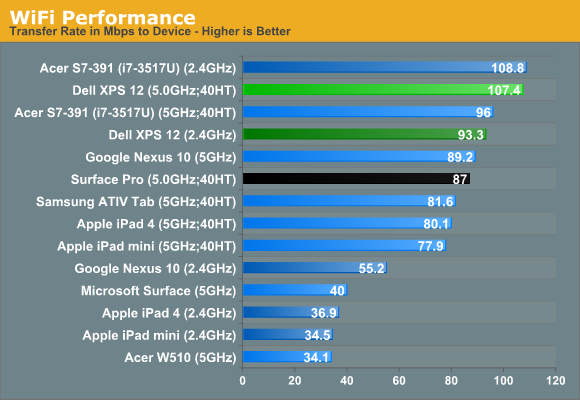
Above is a quick check of WiFi performance compared with some tablets and other laptops. The XPS 12 is about average for a 2x2:2 solution, with slightly better throughput on 5GHz than on 2.4GHz. I’ve seen some WiFi adapters push closer to 150-200Mbps on a 5GHz 2x2:2 solution (e.g. the Amped Wireless adapter), so I’m not sure why most other WiFi adapters are so slow by comparison. Partly it’s probably Intel’s drivers, which may favor reliability or neighbor-friendliness over pure speed, but then on the XPS 12 the reliability aspect wasn’t all that great either.
Display Testing
I have to throw this out before I get into the display calibration results: I’m no longer confident that our testing procedure works properly for Windows 8 laptops. Everything looks okay, but either these new 1080p IPS displays are trading color quality for viewing angles or else the calibration routines aren’t working quite right. I mention this because the XPS 12 has great viewing angles and decent contrast but color accuracy and quality are decidedly average. And that’s after calibration—out of the box, Delta E is probably in the double digits. Here are the charts.
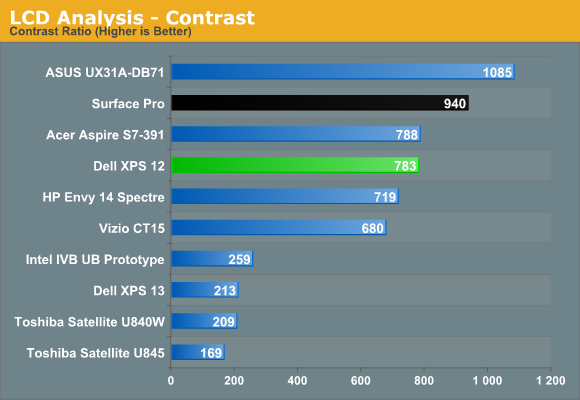
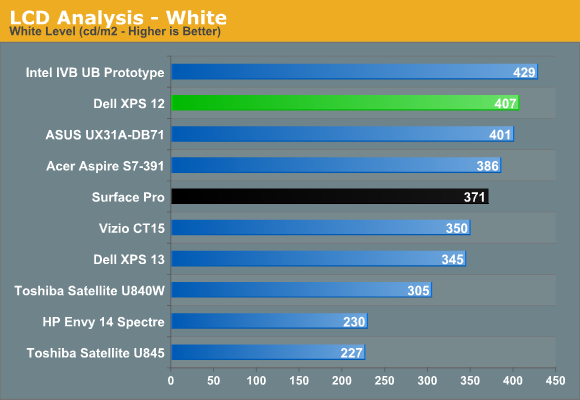
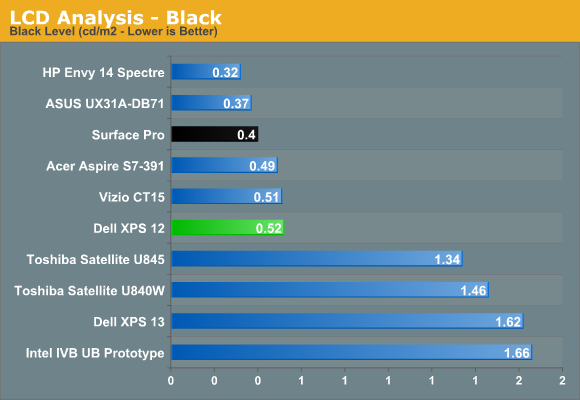
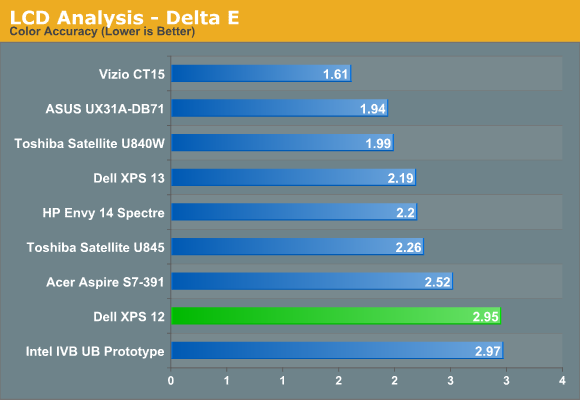
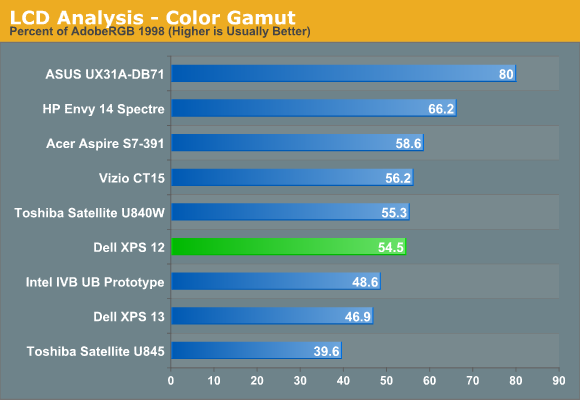
This once again highlights the need for OEMs to take displays seriously; Apple is spending the extra dollar or two (or maybe even five according to some rumors) to calibrate their laptop, tablet, and smartphone displays so that colors are reasonably accurate and color gamut matches the sRGB color space. Virtually everyone else is way off in terms of what colors are supposed to look like. While I can see not spending the extra money on a crappy TN panel in a $400 budget laptop, when we’re looking at $1200+ Ultrabooks the costs argument just doesn’t hold water. Ideally, every Ultrabook should be factory calibrated to deliver an average Delta E of less than three out of the box. Dell gets there post-calibration but only barely, and maximum brightness with the color profile loaded drops to around 300 nits.


_thumb.jpg)
_thumb.jpg)
_thumb.jpg)
_thumb.jpg)
_thumb.jpg)
_thumb.jpg)








59 Comments
View All Comments
JarredWalton - Tuesday, February 26, 2013 - link
There's a specific application I use on my Android tablet (that is also available on iOS) that has text versions of several thousand books and magazines, and it's all linked together (e.g. you'll see a reference to an article and you can click it to go there). All of the content is freely available on the Internet, but instead of staying within a unified full-screen app (with the ability to make notes and highlight material), you end up having a bunch of web pages open (which requires an active Internet connection) and you can't take notes directly or highlight passages, nor can you have any notes sync between devices.The best you can find in the Windows Store right now is an app that only has about five books, none of the magazines or other manuals, etc. I'm pretty sure the group that makes the apps for Android and iOS will have a Windows Store app in the future, but it might be a year or two (or it might be a month or two -- who knows?).
When I use the XPS 12 as a laptop, none of the above bothers me much, but in tablet mode the fullscreen apps are far more important. I don't want to open web pages and type URLs if I don't have to; I don't always have Internet either. I don't have a GPS in the XPS 12, which makes getting turn-by-turn navigation directions impossible (sometime I can get on a $200 or less Android tablet).
AncientWisdom - Wednesday, February 27, 2013 - link
" Maybe it was all in my head, but those extra couple inches make a big difference. " (Page 3)Sure made me laugh :-)
IndyJaws - Wednesday, February 27, 2013 - link
I have a 15z, and while I've been happy with it overall, the Cypress touchpad is proof Satan exists. I'd have hoped they got their act together in the 2 years since I got my machine, but the issues Jarred describes are very similar here, but to an even worse degree. I've only recently found a driver for another Dell laptop that has made it semi-usable, but for the most part, I find myself using a wireless mouse instead.vectorm12 - Sunday, March 3, 2013 - link
I keep wondering where the sub 700 € ultrabooks powered by AMD hardware went?There was loads of talk about how OEMs would design one Intel "Premium" ultrabook which would then filter down into more affordable and probably similarly performing ultrathins with AMD hardware inside?
Right now I'm looking to replace my wife's 13" Macbook Pro with something halfway decent, but considering the small difference in price and the unfortunately high amount of shortcomings I'm still inclined to think spending a couple of hundred more on an Air is the smarter choice given the standard she's used to from the MBP.
Dell, HP, Asus and the other OEMs should be able slam Apple on price/performance but in this case they are more like equals.
At least I'm happy to see highres displays starting to show up on these machines.
Honestly I feel a 13" MBP equipped with the retina display would be solid value. User-upgradeable battery, RAM(2 SO-DIMMs instead of the stupidly soldered primary SO-DIMM) and SSD/HDD. Would kill all competition even if it was priced similarly to the 13" "MBP with retina display".
CeriseCogburn - Monday, March 4, 2013 - link
It's the proletariat crap consumerism we have nowadays.Then we get the insane bottom dollar acquisition talks about Apples production takeover strategies, and what's left is the crap sandwhich everyone pretends to hate until they buy one, then the love never ends.
If anyone does produce the correct device that isn't a crap sandwhich, the first and only thing anyone ever hears is it's a ripoff.
Instead, we get a crap sandwhich, and an on the spot economics lesson by the posting would be CEO, who notes that 50 cent a bom is 50 million bucks.
So expect many crap sandwhiches, forever.
JasonJ65 - Thursday, March 14, 2013 - link
This Dell XPS 12 is by far the worst device that I have ever purchased. Touch screen stops working all the time, constantly unable to connect the wifi, cannot find hot spots, crashes at least once per week. Dell's solution is to continue reinstalling the drivers. Not what I expected for $1700. I've gone back to my $300 HP2000 which has turned out to be a much better purchase.simonmarksmith - Sunday, April 21, 2013 - link
If the touchpad or touch screen stop working on your XPS try touching the metal casing with your other hand... Here's a video of what I found happened with mine.http://www.youtube.com/watch?v=B3fWIEtOFfk
sheehanje - Monday, April 22, 2013 - link
I know I'm a bit late to the party with this review comment - but I would first like to point out that prices have started coming down on the XPS 12. I got an 8GB i7 model with 250GB SSD for $1300, and they are dropping even further.As a Network Analyst/Engineer/Duct Tape Master, I am constantly in wiring closets, in meetings, and on the go. The XPS is what I would call a perfect blend of Laptop/Tablet. For MY purposes, it works better than any other hybrid out there. One reason the flip screen works so well is for documentation - I can use it in full tablet mode, or just flip the screen around easily go through large PDF's in either portrait or landscape using the base (keyboard) as a prop. It is sturdy, unlike most tablet stands, were I can navigate without worrying about the unit flopping over.
There are some glaring omissions on what could be a grand slam of the jack of all trades laptop. GPS is not included, which is disappointing to me. It's not a deal breaker by any means, but the cost of adding GPS is negligible these days in a modern device. Also, as mentioned, there is no digitizer pen capability with the XPS 12. I don't find that as crucial. It would be nice, but it does reduce the sensitivity of the touch screen - which the XPS is one of the best touchscreens I've ever used. I just ordered a Jot Pro for note taking - but even that will be used sparingly.
My last con is the touchpad - it is ill conceived to say the least. I've had all the mentioned issues - and it has horrible response. Button presses often go amiss. One thing I will say, it has gotten me used to the touchscreen, because I'm now constantly trying to use gestures on my non touch screen Mobile Precision laptop.
I highly recommend this hybrid to anyone that needs flexibility between a laptop and tablet. Especially IT pro's that need to between the office and the field. (The field being wiring closets or datacenters). To me, Dell hit a triple with this. It is so close to being a home run, but I'll take it given the current generation of Tablet/Laptops hybrids.
rburnham - Wednesday, May 8, 2013 - link
I don't mind the price of this because the specs are really good. However, the bulk worries me. In order to get a tablet with 256 gigs of storage and a 1080p screen, it seems like just about everything I can find are these sort of thick hybrid/convertible units. Sony's Duo slider unit comes to mind.What I would really like to see is something with a detachable keyboard, like Samsung's 700T tablet, which has the perfect style, but with 256 gigs of storage.
I have not found the perfect Windows 8 tablet yet, but the XPS 12 come really close.